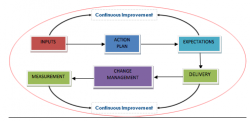 We have been hearing about how the shortage of talent in the market has been impacting business and its growth for a quite a few years. Given the current economic climate, it now seems that the opposite is actually true, where a lot of qualified candidates are available in the marketplace and the companies are finding it difficult to source and recruit the right ones.
We have been hearing about how the shortage of talent in the market has been impacting business and its growth for a quite a few years. Given the current economic climate, it now seems that the opposite is actually true, where a lot of qualified candidates are available in the marketplace and the companies are finding it difficult to source and recruit the right ones.
The key is to come up with a water-tight recruiting strategy and measure its success using the right metrics. This outline will help companies do just that.
This is not a one-size-fits-all solution, so companies must ensure that they tailor this model to meet their needs.
Process Outline
INPUTS
The first step in the process is to ensure that companies have all the inputs that would be required as follows:
- Long range and annual operating plans for the business
- Workforce plan: 1) Hiring volume for a period of 12 months; 2) Business scenarios that could spike the volume
- Critical roles
- Compliant and attractive job descriptions
- Key success factors and key performance indicators for the role from hiring managers
- Talent availability: external — market analysis, internal — talent review process, performance and succession plans
- Employer branding and value proposition: 1) Why work for this company?; 2)What do the current employees say about this company?; 3) What is the current turnover rate?
ACTION
The second step in the process is to come up with an action plan based on the inputs from Step 1.
- Identify sourcing channels: 1) Referral program; 2) Campus; 3) Industry associations/user groups; 4) Social networking sites; 5) Open house on campus
- Create sourcing calendar: 1) Content 2) Target dates
- Go-to-market strategy: Posting & sourcing strategy — identify sources to target
- Build talent community: 1) Set up pipeline positions in ATS; 2) Attract talent; 3) Nurture the community
EXPECTATIONS
The third step in the process is to make sure that companies have what is required to execute on the plan.
- Budget: 1) To staff the recruiting team appropriately 2) To execute programs as may be required
- Right people on the bus to deliver on the sourcing strategy: Acquire talent/upgrade talent /training
- Recruitment model aligned with HR operating model and business model
- Hiring managers available for strategy sessions and interviews
DELIVERY
The fourth step in the process is to deliver on the model that has been put in place.
- Understand the long range and annual operating plans
- Understand the current workforce landscape: 1) Attrition risk; 2) Retiree risk; 3) Talent review process; 4) Succession Plan
- Come up with a staffing plan based on short-term and long-range plans for the business
- Identify gaps
- Come up with strategy for filling the gaps — acquisition of top talent (game changers)
- Build staffing team required to deliver on these requirements: 1) Resource allocation model driven by time factor for each task in the recruitment process; 2) Scalable model
- Build and execute the sourcing strategy
- Refine plan every quarter to adjust to business changes
CHANGE MANAGEMENT
The fifth step in the process is to have a robust change management plan in place to drive this change through the organization.
- Why is this being done
- Importance of the initiative to the organization and its bottom line
- Your role in impacting the company positively
- WIIFM factor
- Identify stakeholders, influencers, and naysayers: Objection handling
- Build a coalition
- Communication
MEASUREMENT
What cannot be measured cannot be improved so it is imperative to come up with Key Performance Indicators and measure performance and delivery against those.
- Determine what KPIs are important for the function and business: Establish KPIs
- Include KPIs in individual performance plans
- Introduce an incentive plan that ties reward to performance if possible
- Set up process and system to measure against these KPIs
- Analyze these numbers
- Measure and re-calibrate periodically
- Measures: 1) Time to fill; 2) Quality of Hire — hiring manager surveys, time to productivity, retention; 3) Recruiter productivity: Break the recruitment process into several steps; Measure time taken to fulfill each step of the process
- Recruitment Cost Ratio (Total Recruitment Spend/Total Compensation Recruited)
- Opportunity Cost of Vacancies: Total Comp. Recruited * Time to fill (+14)/365
Finally, note that this is a continuous improvement initiative and must be constantly refined based on changes in the economic climate, business requirements, and feedback received from the stakeholders. To ensure success companies must make sure that their recruiting model is aligned to the business model to help deliver on business results.